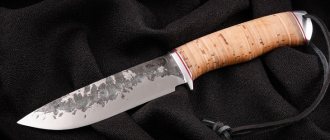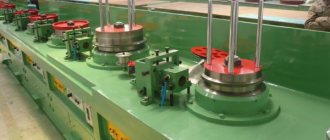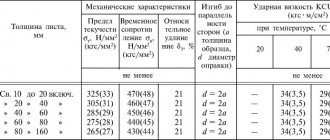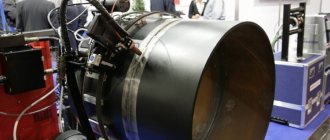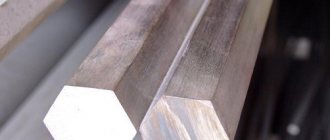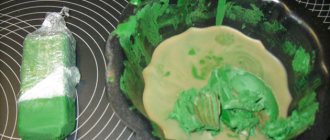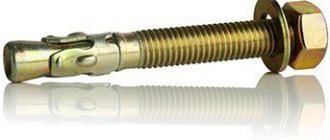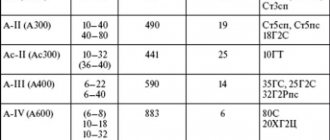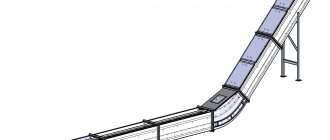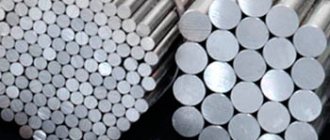Chemical composition and basic performance properties
Grade P18 is classified as high-speed tool steel.
The composition includes the following chemical elements:
- C 0.73 - 0.83;
- Si up to 0.5;
- Mn up to 0.5;
- Ni up to 0.4;
- S up to 0.03;
- P up to 0.03;
- Cr 3.8 - 4.4;
- Mo up to 1;
- W 17 - 18.5;
- V 1 - 1.4;
- Co up to 0.5;
- Fe ~73.
A set of these substances gives this steel certain properties that make it possible to use it for the production of cutting tools for turning and milling machines, thread-forming machines, for making and processing holes. This tool processes parts made of alloy, carbon and structural steels with a tensile strength of up to 1000 MPa. In addition, this tool can be used to process non-ferrous metals.
During cutting processes, tools made from P18 steel retain their performance parameters at temperatures up to 600 ºC.
GOST
Steel manufacturers produce the following range of products:
- Rolled products of different sections - GOST 1133-71;
- Strips of different shapes - GOST 4405-75;
- Rods, incl. calibrated - GOST 4405-75;
- Profile TU 14-11-245-88.
Only a small part of the range of rolled steel products is listed.
Analogs of steel P18
Among the domestic steels intended for the production of tools, you can choose an analogue - P12. The following brands are produced abroad:
- USA - T1;
- Germany - HS18-0-1;
- European Union - 1.3355;
- China - W18Cr4V.
High-speed steel marked P18, containing 18% tungsten, has been used for a long time in the production of most cutting tools. After undergoing heat treatment, its hardness was 62 - 65 HRC and has good strength. The disadvantage of this material is rightly considered to be carbide heterogeneity, especially for large diameter rods.
This is interesting: Types of metal forming
Main characteristics
Rapid steels include metal alloys to which additional substances have been added that improve their chemical and physical properties. Thanks to this, the metal alloy becomes strong, wear-resistant, unable to come into contact with oxygen and become covered with rust. R6M5 high-speed steel differs from conventional carbon alloys in that it can process any hard material at high speed, while having good wear resistance.
Microstructure of R6M5 steel
It has unique properties that make it possible to produce tools such as cutters, taps or reamers. Made from this alloy, they will serve the owner faithfully for a very long time.
And the most famous and characteristics of steel grade R6M5 include:
- The hardness of steel grade R6M5 when heated. Typically, other alloys, during long-term and non-stop drilling, begin to heat up, and with increasing temperature, as is known, the metal begins to soften. And the drill loses its abilities and becomes fragile. The same high-speed steel can heat up to 6000 °C, maintaining its initial properties and without losing strength.
- Increased resistance to incandescence at fairly high temperatures.
- Holds an edge very well.
- Has high viscosity.
- Excellent processing on grinding equipment.
- Holds impact loads perfectly.
The characteristics of R6M5 steel listed above make the metal alloy indispensable in construction.
Chemical composition
The metal contains:
- 73% ferrum;
- 17.75±0.75% tungsten;
- 15% molybdenum;
- 4.1±0.3% chromium;
- 1.2±0.2% vanadium;
- 0.78±0.05% carbon;
- 0.5% each of cobalt, manganese and silicon;
- 0.4% nickel;
- 0.03% each of sulfur and phosphorus.
Compliance of the composition of P18 steel with the specified standards ensures its strength, reliability and durability, allowing it to be used for the manufacture of tools and parts for turning and milling machines, cutting internal and external threads, creating and processing holes. The metal is suitable for machining alloyed, carbon, structural steel with a tensile strength of up to 1 GPa, and non-ferrous metals.
Maintaining operating parameters is ensured at temperatures below 600 C.
P18
P18 contains a large number of substances that improve the properties of steel. The main one is tungsten. The letter P in the stamp means it contains tungsten, and the number 18 indicates the percentage of tungsten. In addition to tungsten, P18 contains many other substances: 0.8% carbon, which gives high hardness, 0.4% manganese and silicon, which improve toughness, 4% chromium, which slows down rusting, 1.2% vanadium, which is responsible for overall strength, and 0.5% cobalt, for due to which cutting properties are ensured. The iron content in this steel is 73%, which is not very much.
Since this type of steel is often used for tools, molybdenum is added for heat resistance and nickel for ductility.
The metal is hardened up to three times - after the second hardening at a temperature of 400 degrees, it becomes stronger, and after the final third, it becomes especially hard.
All these properties classify P18 as high-speed - a tool made of this steel can work up to 4 times faster than a simple one. Let us now consider the pros and cons of this alloy for making knife blades.
P18, interpretation of steel markings
The designation of the alloy grade is clear to the enlightened. It is deciphered as follows:
- R - high-speed steel;
- 18 - tungsten content.
In addition to tungsten, the alloy also contains:
- Fe (iron) - 73%;
- Cr (chrome) - 4%;
V (vanadium) - no more than 1.4%;- Mo (molybdenum) - less than 1%;
- C (carbon) - 0.8%
- Si (silicon) - 0.5%;
- Mn (manganese) - 0.5%;
- Co (cobalt) - 0.5%;
- Ni (nickel) - 0.4%;
- S (sulfur) - 0.03%;
- P (phosphorus) - 0.03%.
Decoding: what do the marking symbols mean?
It was already described above what data can be extracted from the name of any brand of high-speed cutters. For greater clarity, let’s consider the decoding of one widely used high-speed steel R9F5:
- P – understandable, designation of high-speed alloys, from the English “rapid” – speed;
- 9 – percentage of tungsten in the alloy;
- F – indicates the presence of vanadium in the steel;
- 5 – percentage of vanadium.
If we analyze the abbreviation R9F5 further, then its decoding may contain other letters. For example, if the metal is obtained by electroslag remelting, another letter appears - “Ш”.
With the introduction of modern technologies, namely the use of nitriding, you can find the following marking R9AF5.
Imported analogues of high-speed cutters have the following marking - HSS, which stands for High Speed Steel, translated into Russian - this is high-speed steel:
- Germany – 1.3343;
- Japan – S600/S601;
- USA - M2.
Steel marked R9F5.
Production and Processing Methods
For the production of tools made from high-speed alloys, two main technologies are used:
- the classical method, which involves casting molten metal into ingots, which are then subjected to forging;
- a method of powder metallurgy in which molten metal is atomized using a stream of nitrogen.
Classic technology, which involves forging a product from a high-speed alloy that has previously been cast into a special mold, allows such a product to be endowed with higher quality characteristics.
This technology helps to avoid the formation of carbide segregations in the finished product, and also makes it possible to subject it to preliminary annealing and further hardening. In addition, this manufacturing technology avoids the phenomenon of “naphthalene fracture”, which leads to a significant increase in the fragility of the finished product made from a high-speed alloy.
» data-lazy-type=»iframe» src=»data:image/gif;base64,R0lGODlhAQABAIAAAAAAAP///yH5BAEAAAAALAAAAAABAAEAAAIBRAA7″>
Hardening of finished tools made of high-speed alloy is carried out at temperatures that promote better dissolution of alloying additives in them, but at the same time do not lead to grain growth in their internal structure. After hardening, high-speed alloys have up to 30% austenite in their structure, which does not have the best effect on the thermal conductivity of the material and its hardness. In order to reduce the amount of austenite in the alloy structure to minimum values, two technologies are used:
- carry out several cycles of heating the product, holding it at a certain temperature and cooling: multiple tempering;
- Before tempering, the product is cooled to a fairly low temperature: up to –800.
» data-lazy-type=»iframe» src=»data:image/gif;base64,R0lGODlhAQABAIAAAAAAAP///yH5BAEAAAAALAAAAAABAAEAAAIBRAA7″>
Cutting Application
Tool sharpening is 2-4 times faster when using P18 steel grade. It is used for the manufacture of cutting tools used in difficult conditions, including heating and high loads. This ensures that the basic technical characteristics of the products are preserved, which is an advantage. This parameter is necessary when creating automated workshops.
The high quality of the cut is due to the presence of alloying components in the material. Sharpening is carried out using emery wheels, but during the process it is important to eliminate dynamic and vibration effects.
Return to content
Assortment
Products are produced in accordance with regulatory documents, which are GOST:
- No. 1133-71 – rolled elements;
- No. 4405-75 – strips and rods;
- TU 14-11-245-88 – profiles.
There are also other types of rentals.
This is interesting: Carbon (carbon) steel: types, production and application
Production of cutting tools
The price of P18 steel is determined by the type of rolled product, taking into account the weight of the product and the volume of the order. One of the types of finished products is a drill, which is manufactured based on the requirements of State Standard 2034-80. These include the need to ensure a shank hardness of 63-68 HRC.
Grinding is the next stage after heat treatment. For this purpose, special machines are used that can guarantee compliance with the tolerances for the processed product - A1 and B1 according to h8, B - h9.
Return to content
Characteristics and Application
Speaking about p18 steel, characteristics and application, it should be noted that tools made from it after heat treatment have a hardness of HRC 62...65 units and high strength. This is quite enough for processing structural steels of ordinary quality. Long-term red resistance without loss of strength allows for long-term processing of parts.
But the big disadvantage of the alloy is carbide heterogeneity. This is especially noticeable in large-diameter workpieces. In large tools, this disadvantage manifests itself as a decrease in durability and chipping of cutting elements.
The problem is solved by increasing the excess amount of carbide phase. Heat treatment makes the internal structure of the steel fine-grained.
Material properties
P18 steel has the following physical properties
| Parameter | Unit |
| Density, | 8800 kg/cm3 |
| Modulus of elasticity, E | 220 GPa |
| Torsional shear modulus, G | 83 GPa |
| Thermal conductivity | 28 W/(m degrees) |
Electrical resistivity depends on the heating temperature of the metal
| Electrical resistivity | |
| Temperature, degrees | Quantity |
| 20 | 420 |
| 100 | 470 |
| 200 | 545 |
| 300 | 630 |
| 400 | 720 |
| 500 | 815 |
| 600 | 920 |
| 700 | 1035 |
| 800 | 1150 |
| 900 | 1175 |
Mechanical properties are isolated from the manufacturer’s plant and after heat treatment
From the manufacturer
| Tensile strength, Ϭ B | 830 MPa |
| Maximum fluidity, Ϭ T | 450 MPa |
| Linear elongation, δ 5 | 13% |
| Restriction limit, ψ | 22% |
| Ultimate compressive strength, Ϭ SJ | 1050 MPa |
| Hardness, HB | 227 |
| Impact strength, KCU | 100 kJ/m2 |
After heat treatment
| Parameter | Value, MPa |
| Ϭ V | 2150 |
| Ϭ T | 2480 |
| Ϭ SJ0.2 | 3060 |
| Ϭ SJ | 3820 |
| Ϭ IZG | 3000 |
| Tk | 1880 |
Heat resistance (red resistance). At 610 °C the hardness is HRC 59 for 4 hours .
Technological properties
| Forging temperature | 900 °C - 1200 °C |
| Cooling after forging | 750 °C - 800 °C, well |
| Weldability | Good, no restrictions |
| Machining | HB up to 228, K v = 0.3−0.6 |
| Grinding processing | Increased |
| Flock sensitivity | Negative |
Steel brand characteristics, properties of steels and alloys
Price
Tool high-speed steel P18 is used for the manufacture of cutting tools (all types) when processing structural materials.
| Rolled metal grade | Substitute |
| P18 | P12 |
| Brand | Classification | Type of delivery | GOST | Foreign analogues |
| P18 | High-speed tool steel | Rods and strips | 19265–73 | There is |
Welding
| Weldability | Welding methods | Recommendations |
| no limits | butt welding | good weldability with steels 45 and 40Х |
cutting
| Initial data | Machinability Ku | |||
| State | HB, MPa | sB, MPa | hard alloy | high speed steel |
| annealed | 212–228 | 800 | 0,6 | 0,3 |
Mass fraction of elements no more than, %:
| Vanadium | Tungsten | Silicon | Cobalt | Manganese | Copper |
| 1–1,4 | 17–18,5 | 0,2–0,5 | 0,5 | 0,2–0,5 | 0,2 |
| Molybdenum | Nickel | Sulfur | Carbon | Phosphorus | Chromium |
| 1 | 0,6 | 0,03 | 0,73–0,83 | 0,03 | 3,8–4,4 |
| Assortment | GOST | Dimensions – thickness, diameter | Heat treatment mode | t | KCU | y | d5 | st | sв |
| mm | 0C | kJ/m2 | % | % | MPa | MPa | |||
| Rental | 19265–73 | delivery status | 190 | 10 | 8 | 510 | 840 |
Red fastness
| t | HRСе | Time |
| 0C | h | |
| 620 | 59 | 4 |
| t | r | R 109 | E 10-5 | l | a 106 | C |
| 0C | kg/m3 | Ohm m | MPa | W/(m deg) | 1/Grad | J/ (kg deg) |
| 20 | 8800 | 419 | 2.28 | |||
| 100 | 472 | 2.23 | 26 | |||
| 200 | 544 | 2.19 | 27 | |||
| 300 | 627 | 2.1 | 28 | |||
| 400 | 718 | 2.01 | 29 | |||
| 500 | 815 | 1.92 | 28 | |||
| 600 | 922 | 1.81 | 27 | |||
| 700 | 1037 | 27 | ||||
| 800 | 1152 | |||||
| 900 | 1173 |
| Austria | England | Bulgaria | Hungary | Germany | European Union | Spain | Italy | ||||||||||||||||||||||||||||||||||||||||||||||||||||||||||||||||||||||||||||
| ONORM | B.S. | BDS | MSZ | DIN, WNR | EN | UNE | UNI | ||||||||||||||||||||||||||||||||||||||||||||||||||||||||||||||||||||||||||||
|
Heat treatment P18
As previously noted, to significantly improve the performance characteristics of the material, heat treatment is carried out. The characteristics of the chemical composition determine which modes are used.
High speed steel P18 is improved as follows:
- During hardening, the workpiece is heated to a temperature of 1300 degrees Celsius. This is due to the fact that cobalt significantly increases the temperature of structural transformation. In order to eliminate the possibility of structural cracks, stepwise heating is carried out. The holding time depends on the thickness of the workpiece and its linear dimensions. Cooling of the workpiece is carried out in the open air in case of large sizes. Water is practically not used as a cooling medium, since uneven cooling leads to the appearance of surface and structural defects. Recently, oil has been used for cooling, which ensures uniform cooling.
- A fine-grained structure can be obtained by tempering at a temperature of 560 degrees Celsius. Cooling in this case is carried out in the open air.
After heat treatment, the possibility of improving the performance characteristics of the alloy should be considered. To do this, the chemical composition is changed during the following procedures:
- Sulfidation.
- Nitriding.
- Cyanidation.
- Steaming.
A similar improvement is also carried out after sharpening and polishing a cutting tool or other product. Due to this, the surface layer is given greater strength. Special equipment can be used to heat the workpiece and add chemicals. It is worth considering that the high heating temperature does not allow processing at home.
pros
- High quality . Products made from this steel will almost certainly be free of defects, due to the quality of the raw materials. Therefore, when buying a quick cutter from P18, you don’t have to worry.
- High hardness is very important for any cutting tool. And grade P18 has a hardness on the Rockwell scale from 65 to 64. For a knife, such hardness is considered very high, which classifies such a blade as a high-speed blade. It will very rarely have to be sharpened, because it does not become dull on ordinary materials - it can cut wood almost without hindrance.
- Good elasticity and impact strength due to additives . Usually, hard metal also turns out to be brittle - it is easy to break under lateral loads on the tool. But this alloy, as a rule, will bend, but not break, because some impurities, especially manganese and nickel, make it more flexible and ductile. Carbon and silicon not only add strength, but also protect against breakage. Therefore, saws and cutters are made from P18, which work great.
- The P18 blade has good cutting abilities , does not dull for a long time, and holds an edge well. The admixture of cobalt helps here, which is responsible for the cut. It helps the blade hold an edge, and also allows you to sharpen the blade to a razor sharpness, which it will maintain even during hard work.
- With this knife it will be possible to cut products made of softer materials . This alloy is traditionally used for metal cutting tools.
- In general, this type of steel can be considered almost perfectly balanced - it is distinguished by its hardness, is quite durable, and retains its cutting ability for a long time. Users note that of all high-speed steels, P18 is one of the best. The combination of all these properties makes it an ideal candidate for premium knife steel.
Physical properties of P18
| Test temperature, °C | 20 | 100 | 200 | 300 | 400 | 500 | 600 | 700 | 800 | 900 |
| Modulus of normal elasticity E, GPa | 228 | 223 | 219 | 210 | 201 | 192 | 181 | — | — | — |
| Density, pn, kg/cm3 | 8800 | — | — | — | — | — | — | — | — | — |
| Thermal conductivity coefficient W/(m °C) | — | 26 | 27 | 28 | 29 | 28 | 27 | 27 | — | — |
| Electrical resistivity (p, NΩ m) | 419 | 472 | 544 | 627 | 718 | 815 | 922 | 1037 | 1152 | 1173 |
| Linear expansion coefficient (a, 10-6 1/°С) | — | — | — | — | — | — | — | — | — | — |
| Specific heat capacity (C, J/(kg °C)) | — | — | — | — | — | — | — | — | — | — |
Specifications
The main characteristics of P18 steel are:
| viscosity | 100 kJ/m2; |
| Rockwell hardness | 227; |
| compressive strength | 10.5 GPa; |
| relative extension | 13%; |
| yield strength | 0.45 GPa; |
| tensile strength | 0.83 GPa; |
| ability to conduct heat | 28 W/mK; |
| shear/elastic modulus | 83/220 GPa; |
| specific gravity | 8.8 t/m3. |
Return to content
Mechanical properties of steel P in the delivered condition (after annealing) at elevated temperatures
| Test temperature, °C | 200 | 400 | 600 | 800 | 1000 | 1100 | 1200 |
| σ0.2 (MPa) | 450 (50) | 420 (40) | 300 (40) | 110 (20) | 90 (20) | — | 30 (10) |
| σв (MPa) | 830 (80) | 700 (70) | 480 (50) | 200 (20) | 100 (20) | — | 30 (10) |
| δ5 (%) | 13 (2) | 15 (2) | 31 (3) | 60 (5) | 42 (4) | — | 12 (3) |
| ψ % | 22 (4) | 22 (4) | 55 (6) | 70 (6) | 55 (6) | — | 25 (5) |
| σcom. (MPa) | 1050 (50) | 850 (50) | 620 (40) | 100 (20) | 50 (10) | — | 40 (10) |
| Τk (MPa) | 520 (30) | 450 (30) | 300 (20) | 100 (20) | 50 (10) | — | 40 (10) |
| KCU (J/cm2) | — | — | — | — | 100 (10) | 130 (15) | 45 (5) |
| HB | 227 (6) | 210 (6) | 140 (6) | 30 (4) | 24 (4) | — | 4 (1) |
Scope of application
The properties of P18 steel allow it to be used for the manufacture of all types of cutting tools. Drills, cutters, cutters, reamers, countersinks, taps and other tools that operate under significant loads and heating of the cutting edge are made from this material.
This grade of steel is most widespread among manufacturers of blades and knives. Due to their high hardness, knife blades practically do not become dull. But you can maintain sharpening quality for a long time if you use the blade to process not very hard materials.
Mechanical properties P depending on the tempering temperature
| Temperature, °C | 400 | 500 | 550 | 600 |
| Hardening 1280 °C, oil. Vacation three times for 1 hour | ||||
| σв (MPa) | 1370 | 1470 | 2350 | 2210 |
| KCU (J/cm2) | 23 | 19 | 17 | — |
| HRC ∂ (HB) | 61 | 63 | 66 | 65 |
Classification and marking of high-speed steels
All high-speed steels are classified directly according to their chemical composition, for which purpose the markings are deciphered. High-speed tool steels are divided into the following three groups:
- Alloys with useful impurities, in which the percentage of cobalt is not more than 10%, and tungsten is 22%. The metal markings of this group are as follows: P10M4Ф3К10 and Р6М5Ф2К8 and others.
- Alloys containing no more than 5% cobalt and up to 18% tungsten. The types of high-speed steel in this group are as follows: R9K5, R10F5K5 and others.
- Metal options, the decoding of which determines the percentage of cobalt and tungsten more than 16%. Representatives of this group include brands P9 and P18, P12 and P6M5.
When using such a metal, the resulting edge does not react to mechanical stress, the hardness indicator remains unchanged along the entire length and the metal does not chip. The above classification of high-speed steel determines at what cutting speed and feed the alloy can be used.
Composition of high-speed steels of various grades
When considering the designation of high-speed steel, attention should be paid to the fact that the first letter to designate this group is “P”. The number that comes first in the designation indicates the process of tungsten in the composition
Next may be letters indicating alloying elements. It is worth considering that metal decoding indicates the exact content of certain alloying elements that change the performance properties of the material.
Where is it used?
The metal is widely used in the creation of blade cutting tools intended for machining materials based on iron and carbon with varying degrees of hardness. These include heat-resistant and stainless steels, the hardness of which reaches HRC70. The use of P18 steel ensures an increase in processing speed, eliminates plastic deformation and changes in characteristics as a result of heating.
An increase in the technical parameters of the material is ensured by heat treatment. One of the methods is hardening, which is carried out at a temperature of 1300 degrees. Due to the presence of cobalt in the composition, the temperature increases, at which the internal structure of carbides changes, the main one of which is Fe3W3C. During quenching, most of this substance is converted to hard martensite or austenite.
Low tempering of high-speed steel P18 at t = 550-560 degrees makes it possible to obtain a fine-grained structure. This is due to the decomposition of the residual austenite form and the formation of dispersed carbide compounds.
Alternating heat treatment modes eliminates the risk of cracking. The order most often used is:
- heating up to 500 degrees;
- temperature increase up to 850 degrees;
- setting the temperature to 1300 degrees for a certain amount of time depending on the thickness of the element (1-30 mm, 15 seconds for each millimeter).
After this, stepwise tempering is carried out, which ensures a complete transformation of the residual austenitic structure of P18 steel.
Resistance to corrosion and wear is ensured by additional processing of the cutting part. To do this, one of the methods can be used:
- steaming;
- sulfide coating;
- cyanidation to increase viscosity;
- nitriding to reduce brittleness.
They are carried out after heat treatment, sharpening and grinding, which guarantees increased strength.
P18
P18 contains a large number of substances that improve the properties of steel. The main one is tungsten. The letter P in the stamp means it contains tungsten, and the number 18 indicates the percentage of tungsten. In addition to tungsten, P18 contains many other substances: 0.8% carbon, which gives high hardness, 0.4% manganese and silicon, which improve toughness, 4% chromium, which slows down rusting, 1.2% vanadium, which is responsible for overall strength, and 0.5% cobalt, for due to which cutting properties are ensured. The iron content in this steel is 73%, which is not very much.
Since this type of steel is often used for tools, molybdenum is added for heat resistance and nickel for ductility.
The metal is hardened up to three times - after the second hardening at a temperature of 400 degrees, it becomes stronger, and after the final third, it becomes especially hard.
All these properties classify P18 as high-speed - a tool made of this steel can work up to 4 times faster than a simple one. Let us now consider the pros and cons of this alloy for making knife blades.
Which is better - P6Mili P18?
When choosing a good knife, you will probably see models made of steel grades P18 and P6M5. It is difficult to decide exactly which option is better, since they have similar characteristics. However, there are a number of differences due to the composition of the alloys. P18 contains 17-18.5% tungsten, while P6M5 contains only 5-6.5%. Tungsten carbides make the alloy more resistant to wear, therefore extending the service life of products made from it. Knives made of P18 steel are considered more durable.
Another advantage of knives made from P18 alloy is ease of grinding. Knives made of this metal are easier to sharpen and have a sharper edge. A blade made of R6M5 steel remains sharp for a long time, but sharpening them yourself, at home, is very difficult.
Peculiarities
Steel grades R6M5 and R18 are used not only in the manufacture of knives, but also in the production of taps, drills, and industrial cutting tools. They are distinguished by their ability to maintain hardness and sharpness when exposed to high temperatures and significant shock loads. The high content of carbon and tungsten in the composition gives steel these characteristics.
Heat treatment
To give knives made from P18 and P6M5 increased strength and wear resistance, the metal is subjected to appropriate heat treatment. It takes place in 2 stages:
- Hardening – heating to a temperature of 1200-1300C. To avoid the formation of cracks, it is carried out gradually. First, the metal is heated to a temperature of 400-500C, then to a temperature of 800-850C. At maximum heating, the workpiece is subjected to heat treatment for a limited time (10-15 seconds for each millimeter of thickness). During hardening, the carbide decomposes, the alloy is saturated with tungsten and carbon.
- Vacation is carried out at a temperature of 550-560C. It is carried out in 2-3 stages, each lasting at least an hour. At the same time, the strength characteristics of the metal increase.
Steel is heated in special salt baths, which consist of barium chloride (78%) and sodium chloride (22%). Magnesium fluoride is used to deoxidize the solution.
Production of cutting tools
After heat treatment of the steel, the production of cutting tools begins. For this purpose, the workpieces, which are previously checked for compliance with GOST requirements, are sent for grinding. Products made from P18 steel are easier to grind, but they also retain their sharpness for a shorter period of time. Knives made from R6M5 alloy can only be sharpened with professional tools and skills, but their sharpening quality is much better. In production, specialized machines are used for grinding workpieces made of steel R18 and R6M5.
Knife Grif steel P18, birch bark handle.
Use in cutting
Knives made of steel P18 and P6M5 are quick-cutting and universal in use. The metal performs well under heat and mechanical stress. It does not lose strength or deform. Manufacturers of knives made from these steel grades conducted experiments during which they successfully coped not only with slicing various food products (meat, bones, cartilage), but also with cutting wood and even metal plates several millimeters thick!
Characteristics of high-speed steels
Hot hardness
At normal temperatures, the hardness of carbon steel is even slightly higher than the hardness of high-speed steel. However, during operation of the cutting tool, intense heat is generated. In this case, up to 80% of the released heat is spent on heating the instrument. Due to an increase in the temperature of the cutting edge, the tool material begins to temper and its hardness decreases.
After heating to 200 °C, the hardness of carbon steel begins to rapidly decrease. For this steel, a cutting mode in which the tool would heat up above 200 °C is unacceptable. High-speed steel retains its high hardness when heated to 500–600 °C. High speed steel tools are more productive than carbon steel tools.
Red fastness
If hot hardness characterizes what temperature steel can withstand, then red hardness characterizes how long the steel will withstand such a temperature. That is, how long will quenched and tempered steel resist softening when heated.
There are several characteristics of red fastness. Let's give two of them.
The first characteristic shows what hardness the steel will have after tempering at a certain temperature for a given time.
The second way to characterize red hardness is based on the fact that the intensity of the decrease in hot hardness can be measured not only at high temperature, but also at room temperature, since the hardness decrease curves at high temperature and room temperature are equidistant, and measuring hardness at room temperature, of course, is much simpler than at high.
Experiments have established that cutting properties are lost at a hardness of 50 HRC at cutting temperature, which corresponds to approximately 58 HRC at room temperature. Hence, red hardness is characterized by a tempering temperature at which in 4 hours the hardness decreases to 58 HRC (designation K4р58). Characteristics of heat resistance of carbon and red resistance of high-speed tool steels
| steel grade | Temperature, °C | Exposure time, hour | Hardness, HRCе |
| U7, U8, U10, U12 | 150—160 | 1 | 63 |
| P9 | 580 | 4 | |
| U7, U8, U10, U12 | 200—220 | 1 | 59 |
| R6M5K5, R9, R9M4K8, R18 | 620—630 | 4 |
Fracture Resistance
In addition to “hot” properties, high mechanical properties are also required from the cutting tool material; This means resistance to brittle fracture, since at high hardness (more than 60 HRC) fracture always occurs by a brittle mechanism. The strength of such high-hard materials is usually defined as the resistance to fracture during bending of prismatic, uncut specimens under static (slow) and dynamic (fast) loading. The higher the strength, the greater the force the working part of the tool can withstand, the greater the feed and depth of cut that can be applied, and this increases the productivity of the cutting process.
Chemical composition of high-speed steels
Chemical composition of some high-speed steels
| steel grade | C | Cr | W | Mo | V | Co |
| Р0М2Ф3 | 1,10—1,25 | 3,8—4,6 | — | 2,3—2,9 | 2,6—3,3 | — |
| R6M5 | 0,82—0,90 | 3,8—4,4 | 5,5—6,5 | 4,8—5,3 | 1,7—2,1 | < 0,50 |
| R6M5F2K8 | 0,95—1,05 | 3,8—4,4 | 5,5—6,6 | 4,6—5,2 | 1,8—2,4 | 7,5—8,5 |
| P9 | 0,85—0,95 | 3,8—4,4 | 8,5—10,0 | < 1,0 | 2,0—2,6 | — |
| P18 | 0,73—0,83 | 3,8—4,4 | 17,0—18,5 | < 1,0 | 1,0—1,4 | < 0,50 |
Characteristics of R6M5
Among the key properties of R6M5 are:
propensity to decarbonize;
wear resistance;
high viscosity.
In addition, it can be processed well with grinding equipment.
All of the above characteristics allow it to be used in the production of tool products for a wide range of applications, which can be used to work with structural steels, including alloy steels.
Sometimes P6M5 is called tungsten-molybdenum steel. It is able to maintain its properties even when working at high temperatures. As an example, we can say that after heat treatment, its hardness remains unchanged.
The listed characteristics predetermined its use as a steel used for work at high temperatures.
Another quality of R6M5 steel is that it holds an edge well. In addition, this steel can withstand impact loads well. This allows its use as drills, reamers and other tool products.
Subtleties of heat treatment
Heat treatment of R6M5 has a number of technological subtleties. They are related to the decarburization properties of this steel and the time required to heat to the hardening temperature. It is 1230 degrees Celsius and during the heating process they make a tempering when they reach 200 and 30 degrees; the time for these intermediate operations is one hour. Next, heating is stopped at 690, 860 and 1230 degrees. The first two stops last three minutes, the last ninety seconds.
The rather complex hardening process cannot but affect the price of the alloy and the characteristics of the material.
Upon reaching the set temperature of 1230 degrees, R6M5 is cooled using nitrate, oil and air. After this, tempering is carried out at a temperature level of 560 degrees. The holding time is one and a half hours. At tempering points, alloying additives are added to the alloy, which give the product the necessary hardness.
Before starting all types of heat treatment, the steel must be annealed. This operation reduces fragility while maintaining its strength parameters.
This is interesting: Steel C345 - analogues, explanation, characteristics
